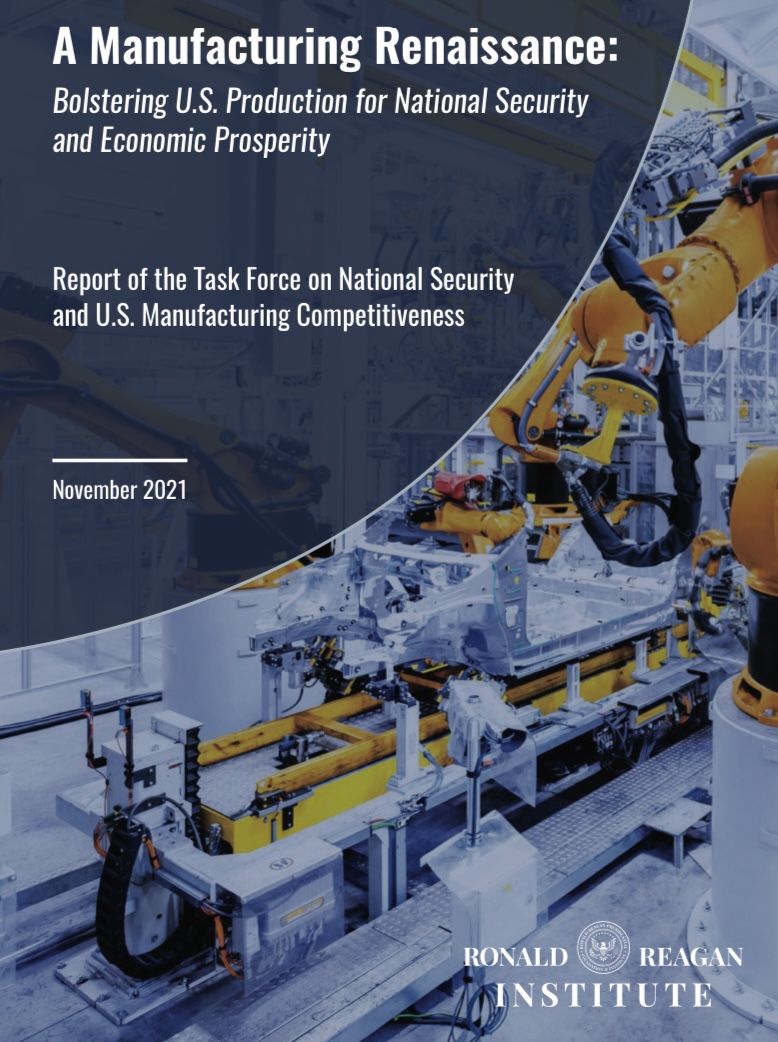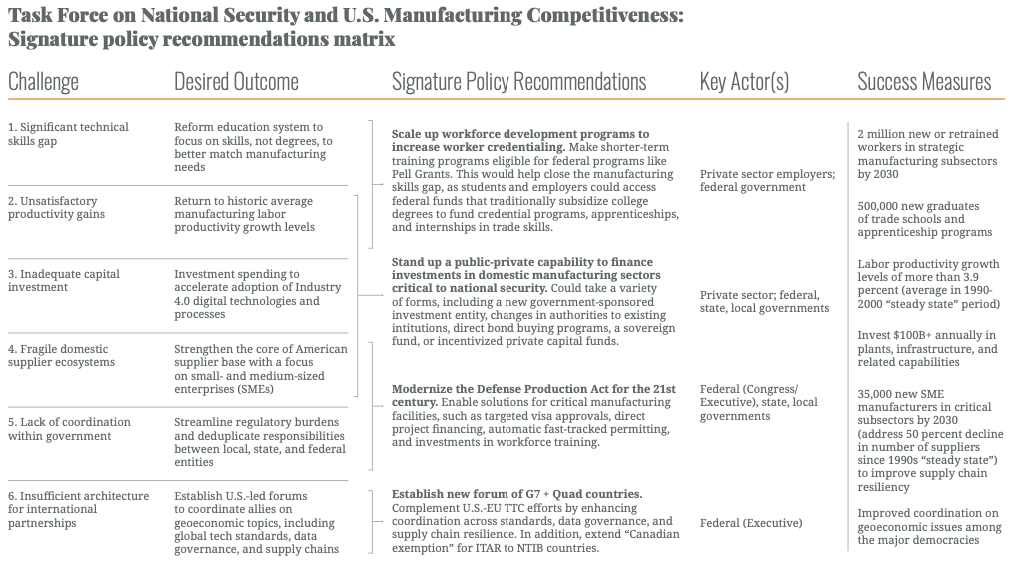The Reagan Institute’s Center for Peace Through Strength, a Washington, D.C. national security think tank (and one of many organizations under the umbrella of the Ronald Reagan Presidential Foundation) has released a report produced by its Task Force on National Security and U.S. Manufacturing Competitiveness. The forty-page report, titled “A Manufacturing Renaissance: Bolstering U.S. Production for National Security and Economic Prosperity”, focuses on four key recommendations, and will be formally presented as part of the 2021 Reagan National Defense Forum in December.

Cover of the Center for Peace Through Strength’s 40 page proposal for restructuring America’s economy
In a press release, the task force summarized its four recommendations, expanded upon in the full report, as follows:
“1. Scale up workforce development programs to credential more workers for high-demand trades…
2. Stand up a public-private capability to finance investments in domestic manufacturing sectors critical to national security…
3. Modernize the Defense Production Act for the 21st Century …
4. Establish a new forum of G7 + Quad countries to coordinate on geoeconomic issues…”

Former chairman, CEO and president of Lockheed Martin, Marillyn Hewson
The task force is comprised of influential individuals comfortable working on both sides of the public/private “revolving door”. It is co-chaired by Marillyn Hewson, former chairman, president, and CEO of Lockheed Martin; and Dr. David McCormick, CEO of Bridgewater Associates (one of the world’s most powerful hedge funds) and former undersecretary of the treasury for international affairs during the George W. Bush Administration.
Although not exclusively centered around additive manufacturing, it’s clear from the details of the full report — and emphasized by the title “A Manufacturing Renaissance”, along with the composition of the task force — that AM is perhaps the central node to the overall playbook. Included in the group, for instance, was John May, founder of CORE Industrial Partners, a Chicago private equity firm that owns CGI Automated Manufacturing, which recently purchased Wisconsin-based Advanced Laser Manufacturing.

CEO of Bridgewater Associates, Dr. David McCormick
In case anyone still doubts that the new Cold War with China is in full swing, co-chair Hewson stated in another press release (from CORE), that, “The economic and national security threat from China cannot be ignored. There is bipartisan support to take action, and this report identifies steps that we can take to strengthen and leverage investments in infrastructure, facilities, technology, and most importantly, people.”
Far be it from me to disagree with America’s power elite, but the spirit of this report continues in what I’ve argued in a number of previous posts (and military spending expert William Hartung also argued on 3DPrint.com) is exactly the wrong direction for 3D printing to be headed in: tripling (quadrupling?) down on military control of American industry; intensification of rhetorical antagonism towards China to drum up conflict; and shutting out the public from any participation whatsoever in decision-making processes that affect everyone’s lives in the most far-reaching ways imaginable.

“Recommendations Matrix” from the task force’s proposal
Of course, since these are the opinions of the power elite, they will almost certainly succeed. Policy statements like this are much like the militaries they’re usually concerned with: they’re invested in so that they can be used. Although the individuals behind it are, to be sure, quick to point out the proposal’s bipartisan credentials, this is less an indicator that some actual consensus is being represented, and more a metric of what exactly “bipartisan” is allowed to mean in Washington, D.C. Bipartisan in favor of increased defense spending is common sense centrism; bipartisan in favor of socially-responsible governance is a “communist plot”.
Make no mistake, this policy statement will form the backbone of the campaign for whoever the Republicans choose as their candidate in 2024. Whoever the Democrats choose will then propose some version of this with phrases like “universal health care” and “green jobs” thrown in there for good measure.
As for the details, they’re essentially identical to what I documented in this post as the military’s years-long project to formulate the nation’s advanced manufacturing strategy, with COVID-relevant updates added in. The overarching recommendations are the important thing. From the mass job retraining to the demand for even greater military stimulus, it’s obvious that American decision-makers aren’t planning on the economy to transition out of depression conditions anytime soon. Ironically, these are exactly the types of recommendations that Keynesians tend to make during economic depressions, which is why it’s appropriate to view this as the opening shot for a future conservative-friendly New Deal.
Images courtesy of Ronald Reagan Institute’s Center for Peace Through Strength.
Subscribe to Our Email Newsletter
Stay up-to-date on all the latest news from the 3D printing industry and receive information and offers from third party vendors.
You May Also Like
AM Under Trump, First Thoughts: Reshoring
Constrained resources and the need to fight climate change have led to a new era of manufacturing focused on re- and nearshoring paired with supply chain resilience. In the battle...
Dyndrite Forms Strategic Partnership with Nikon SLM Solutions for Metal 3D Printing
Dyndrite, the Seattle-based software provider specializing in solutions for digital manufacturing technologies, has announced a strategic partnership with Nikon SLM Solutions to integrate Dyndrite’s LPBF Pro software with Nikon’s metal...
Nikon SLM Hits 1000th 3D Printer Milestone with Bosch Purchase
Nikon SLM Solutions has reached a significant milestone with the production of its 1000th NXG XII 600 system, among the most productive metal additive manufacturing (AM) systems in the industry....
Themes from AM Investment Strategies: Collaboration, Cost Challenges, and Expanding Markets
The 2024 Additive Manufacturing (AM) Investment Strategies event went off without a hitch. The online roundtable, hosted by AM Research (AMR) and Cantor Fitzgerald, dug into the latest trends and...




































